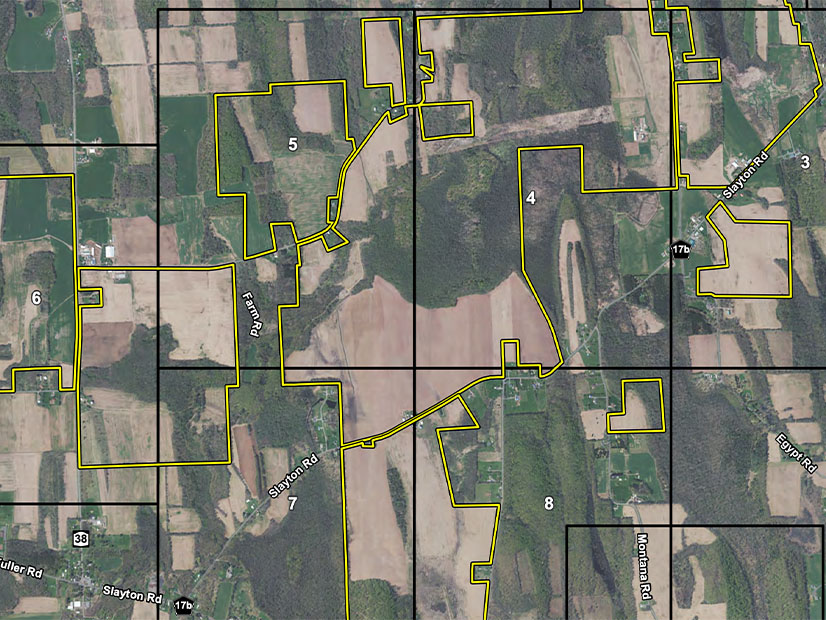Upstate New York residents are concerned that the proposed 200-MW Garnet Energy Center solar facility will diminish their quality of life, harm wildlife and endanger groundwater (20-F-0043).
The application for a certificate of environmental compatibility and public need for the 2,000-acre project in the town of Conquest is flawed in many ways, Eugene D. Moretti, a resident of neighboring Cato, said in written comments.
“Aside from the obvious complete, permanent elimination of hundreds of acres of agricultural production, as well as the devastating impact of deforestation and draining of wetlands, there are several very specific problems with the plans of the applicant,” Moretti said.
All residents of the affected area rely on private wells, and the developer proposes to construct PV panels, fencing, inverters, switching stations, storage units and substations at 250 feet from private dwellings.
“The idea that ground disturbance of that scale and variety will not have a detrimental effect on private wells is, of course, patently absurd,” Moretti said.
The New York Board on Electric Generation Siting and the Environment held two virtual public statement hearings in February on the project, which is being developed by a subsidiary of NextEra Energy (NYSE:NEE). The board has set a May 1 deadline for comments. The project would be located on land owned by Garnet Energy or leased from private property owners.
The interconnection facilities would include a 345-kV switchyard connecting the project to the adjacent 345-kV Clay-to-Pannell transmission line owned by the New York Power Authority, which will own and operate them upon project completion.
Jobs, Traffic, Wildlife
Local grain farmer Donald Waterman supports the project, citing it as a chance for landowners to continue in energy production after the corn-to-ethanol plant in Fulton closes.
“I appreciate that [Garnet] was a voluntary project with the landowners choosing to sign on,” he said.
The project also would provide local jobs and will help the state achieve its renewable energy goals, said Tom McHale, a member of Laborers Local 633.
“I urge you to do everything possible to help make this project a reality. The jobs this project creates will provide good pay and benefits to sustain our families now and into the future,” McHale said.
Some people who live close to the proposed areas are concerned about heavy truck traffic and dust.
Paul and Brenda Bramble said they live within a quarter-mile of the construction drop-off area and are extremely concerned about noise, traffic, safety and traffic delays, among many other issues.
“What will be done to minimize noise and vibration during and after construction of the solar facility? Will work be limited to daylight hours, or will it take place 24/7? Where will employees park, and where will construction vehicles access and exit the construction site?” they asked.
The project involves clear-cutting of forests, destruction of wetlands and spraying of most vegetation, which will split animal families, said Maureen J. Doyle of Jordan. Beaver will lose sticks and leaves they use to build their dams, while wolf, coyotes and foxes will lose beaver as a source of food, she said.
New York’s State Environmental Quality Review Act requires all state and local government agencies to consider environmental impacts equally with social and economic factors, Doyle said. She asked how the state’s Department of Environmental Conservation is addressing compliance with the law.
The size of the project makes for a huge impact to current land usage throughout Conquest, an impact compounded by the project’s noncontiguous design to obtain enough land to meet their 200-MW generation goal, Robert Vogel, chair of the town’s planning board, said in six pages of comments.
The Siting Board should require that far fewer than the more than 20 specified sites throughout the town be covered with solar panels, and even with reduced generation, Conquest will “have done its fair share in contributing to New York’s green energy goals,” Vogel said.
Projects like Garnet should not be being built in upstate, where agriculture and eco-tourism are vital to the regional economies, said Brian Wilson.
“If downstate wants them so much, they should be building these sites in Brooklyn,” Wilson said.



